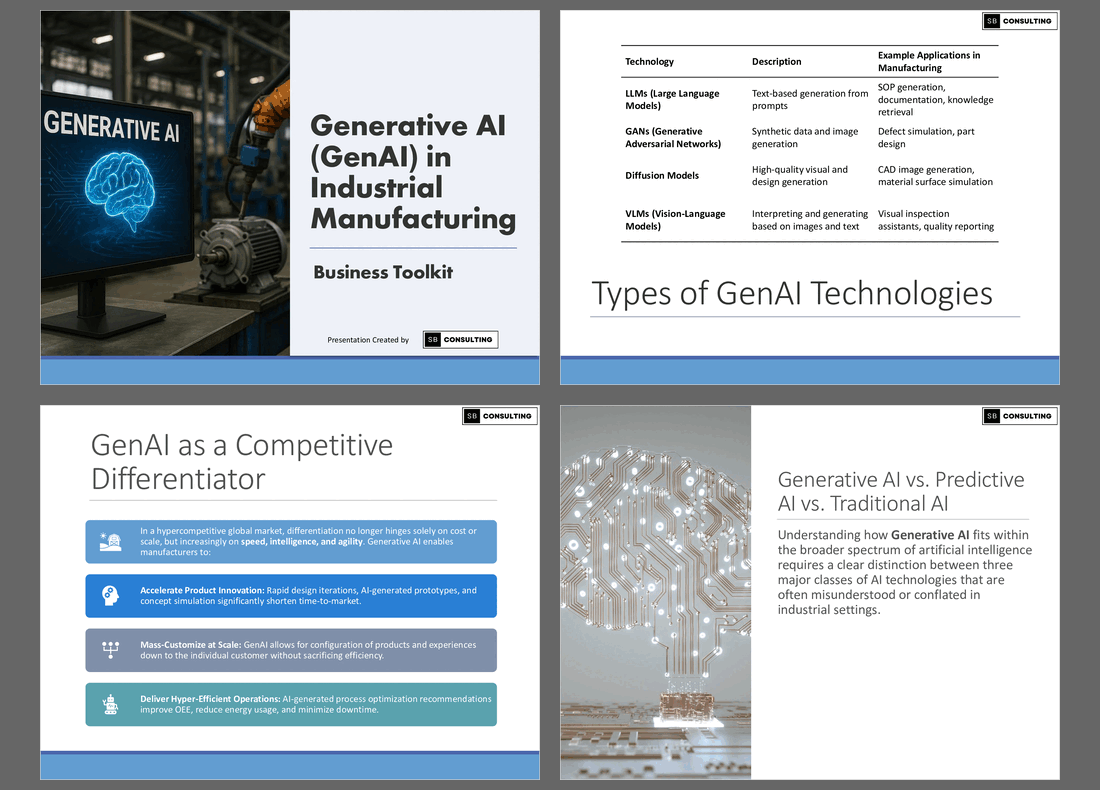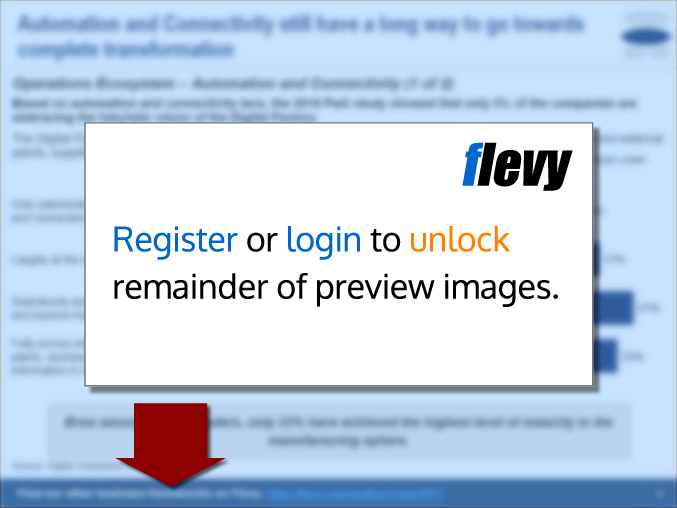Generative AI (GenAI) in Industrial Manufacturing Toolkit (PowerPoint PPTX Slide Deck)
PowerPoint (PPTX) 726 Slides
BENEFITS OF THIS POWERPOINT DOCUMENT
- Equips your organization with a complete roadmap to implement Generative AI across the entire manufacturing value chain.
- Delivers actionable models to align GenAI initiatives with corporate strategy, operations, and workforce transformation.
- Offers a practical toolkit to evaluate, deploy, and scale GenAI solutions tailored to industrial manufacturing environments. Ask ChatGPT
MANUFACTURING PPT DESCRIPTION
Curated by McKinsey-trained Executives
Unlock the Future of Manufacturing with the Ultimate 700+ Slide Generative AI Toolkit for Industrial Leaders
In a world where competitive advantage hinges on speed, precision, and innovation, the industrial manufacturing sector stands on the brink of a transformational leap. That leap is Generative AI—and those who embrace it today will be the leaders of tomorrow. The Generative AI in Industrial Manufacturing Business Toolkit is your all-in-one, deeply comprehensive, and action-ready playbook built to turn AI hype into high-impact industrial results.
This isn't theory. This is execution.
With 700+ expertly curated slides, this premium business toolkit is a battle-tested resource designed for CEOs, CTOs, COOs, digital transformation leaders, plant managers, and innovation strategists who want to take full control of their GenAI strategy and deployment. Whether you're scaling smart factories, reimagining your product lifecycle, revolutionizing predictive maintenance, or augmenting your industrial workforce, this toolkit equips you with the strategic frameworks, use case libraries, implementation roadmaps, technical architectures, and governance protocols to lead decisively.
Why This Toolkit Is a Must-Have for Manufacturing Executives
✅ Built for Real-World Execution – It goes beyond the buzzwords. Each slide is crafted to help industrial leaders prioritize, plan, pilot, and scale GenAI capabilities across their operations—from R&D to factory floor to customer service.
✅ Tailored to the Manufacturing Value Chain – Unlike generic AI playbooks, this toolkit is laser-focused on real industrial applications: generative design, AI-driven simulation, automated quality control, intelligent supply chains, and more.
✅ Comprehensive and Structured – Structured into six core parts and packed with visual models, strategic pyramids, use-case blueprints, maturity assessments, and deployment guides, it supports end-to-end GenAI adoption with clarity and precision.
Accelerate ROI with Proven AI-Driven Value
Generative AI isn't just another wave of automation—it's a paradigm shift. It drives faster time to market, hyper-personalized production, intelligent process tuning, and unprecedented gains in operational efficiency. This toolkit helps you build a compelling business case, model your ROI, and unlock value across the entire manufacturing lifecycle—without getting lost in technical complexity.
CONTENT OVERVIEW
Part I: Introduction to Generative AI in Industrial Manufacturing
1. Executive Summary
• What Is Generative AI?
• Why GenAI Matters in Manufacturing
• Strategic Importance for the Industrial Sector
• From Hype to Reality: Practical Business Use
2. Foundations of Generative AI
• Definition and Key Characteristics
• Generative AI vs. Predictive AI vs. Traditional AI
• Core Technologies: LLMs, Diffusion Models, GANs, Transformers
• AI Model Architectures and How They Work
• Training and Fine-Tuning GenAI Models for Manufacturing
3. The Evolution of AI in Manufacturing
• AI Adoption Timeline in Industrial Sectors
• From Automation to Intelligence: Historical Context
• The Shift from Rule-Based Systems to Learning-Based Systems
4. Business Drivers for GenAI in Manufacturing
• Operational Efficiency and Cost Reduction
• Product and Process Innovation
• Speed to Market and Customization
• Enhanced Safety and Risk Mitigation
• Talent Augmentation and Skill Democratization
________________________________________
Part II: Strategic Frameworks for GenAI Adoption
5. The GenAI Strategy Pyramid
• Vision, Mission, Objectives
• AI-First Business Model Design
• Strategic Alignment with Corporate Goals
6. Maturity Model for GenAI in Manufacturing
• Level 0: Manual-First
• Level 1: Digitally Assisted
• Level 2: AI-Augmented
• Level 3: Fully Integrated GenAI-Driven Operations
• Self-Assessment Checklist
7. GenAI Business Case Development
• ROI and TCO Analysis
• Scenario Planning and Value Projections
• Risk-Adjusted Investment Appraisal
• Financial Modeling Tools for GenAI Initiatives
8. Organizational Readiness for GenAI
• Leadership and Change Readiness
• AI Competency Assessment
• GenAI Governance Model
• AI Center of Excellence (CoE) for Manufacturing
________________________________________
Part III: Use Cases Across the Manufacturing Value Chain
9. Product Design & Development
• Generative Design and Digital Twins
• AI-Driven CAD Modeling and Simulation
• BOM Optimization with LLMs
• Material Innovation Using GenAI
10. Production and Process Optimization
• GenAI in Process Simulation and Optimization
• Workflow Generation and Automation
• Autonomous Process Tuning and Control
• Predictive Maintenance + GenAI Dialogue Agents
11. Supply Chain and Procurement
• Supplier Intelligence via Generative AI
• Automated RFP and Sourcing Bots
• Dynamic Inventory Modeling
• Generative Demand Forecasting
12. Quality Management
• Defect Detection via AI-Generated Inspection Protocols
• GenAI-Enhanced Root Cause Analysis
• Generative Quality Dashboards
• Adaptive Quality Control Systems
13. Workforce Augmentation
• AI Copilots for Engineers and Technicians
• GenAI-Powered SOP Generation and Translation
• VR/AR + GenAI for Training Simulations
• Knowledge Capture and Retrieval Systems
14. Sustainability and Circular Manufacturing
• Generative Lifecycle Assessments (LCA)
• Emissions and Waste Optimization via AI Agents
• Eco-Design with Generative Models
• Closed-Loop Feedback Optimization
15. Customer and Field Services
• Personalized Maintenance Recommendations
• Generative Support Manuals and Chatbots
• Predictive Service Scheduling
• Voice-Activated GenAI Assistants
________________________________________
Part IV: Data, Technology & Architecture
16. GenAI Tech Stack for Manufacturing
• Model Layer (LLMs, Diffusion, GANs)
• Data Layer (Sensor, MES, ERP, PLM)
• Integration Layer (APIs, Middleware, AI Orchestration)
• Deployment Layer (Cloud, Edge, Hybrid)
17. Data Strategy for GenAI Success
• Data Collection and Labeling in Industrial Environments
• Synthetic Data Generation
• Data Lakes vs. Data Fabrics for AI
• Master Data Management (MDM) for GenAI
18. Infrastructure and Platform Considerations
• GPU Clusters, H100, Edge Compute
• Model Hosting and Serving Architectures
• Private vs. Public vs. Open Source Models
• AI Workbench & MLOps Pipelines
19. Cybersecurity and Risk Management
• GenAI-Specific Cyber Threats
• Model Poisoning and Prompt Injection
• Intellectual Property Risks from AI Outputs
• Secure Model Deployment and Monitoring
________________________________________
Part V: Implementation Roadmap
20. GenAI Implementation Lifecycle
• Use Case Prioritization
• MVP Development
• Pilot Testing in Controlled Environments
• Scaling Across Plants and Functions
21. Building the GenAI Operating Model
• Roles and Responsibilities
• Federated vs. Centralized Deployment
• Cross-Functional Collaboration Patterns
• Agile Delivery in GenAI Projects
22. Change Management and Adoption
• Overcoming Resistance to GenAI
• Employee Upskilling and Re-Skilling Paths
• Communicating Value to Frontline Workers
• Culture Shift Toward AI-First Thinking
23. Vendor and Partner Ecosystem
• Selecting AI Vendors and Consultancies
• OpenAI, Nvidia, Siemens, Microsoft: Ecosystem Landscape
• Contracting and SLA Best Practices
• Licensing, IP, and Commercial Terms
________________________________________
Part VI: Metrics, Monitoring & Governance
24. KPIs and Success Metrics for GenAI
• Operational KPIs (Yield, Downtime, OEE)
• Financial KPIs (Cost per Unit, ROI, Margins)
• Adoption Metrics (Usage Rates, Feedback Loops)
• Innovation Metrics (Time to Design, Number of Concepts)
25. AI Model Governance and Compliance
• Model Documentation and Explainability
• Ethical AI in Manufacturing Context
• Bias, Fairness, and Model Validation
• Regulatory Frameworks (EU AI Act, OSHA, ISO AI Standards)
26. Post-Implementation Audits and Continuous Improvement
• GenAI Model Lifecycle Management
• Retraining, Monitoring, and Drift Management
• Feedback Loops for Model Performance
• Governance Boards and Oversight
________________________________________
Part VIII: Future of GenAI in Industrial Manufacturing
29. Next-Gen Capabilities on the Horizon
• Autonomous Plants with AI Agents
• Factory Co-Pilots: Multimodal GenAI Interfaces
• Conversational Manufacturing Engineering
• GenAI + Robotics Integration
30. The Workforce of the Future
• Redefining Human-Machine Collaboration
• AI Literacy for Factory Workers and Engineers
• New Roles: Prompt Engineers, Model Stewards, AI Maintenance Technicians
31. Strategic Forecasting and Scenario Planning
• GenAI Market Outlook in Manufacturing
• Disruption Scenarios and Contingency Plans
• Strategic Pathways to GenAI-Driven Leadership
________________________________________
Part IIX: Checklsits
32. GenAI Implementation Checklists
• Strategy Alignment Checklist
• Use Case Prioritization Checklist
• ROI and Financial Modeling Checklist
• AI Model Selection Checklist
• Data Collection and Labeling Checklist
• Synthetic Data Generation Checklist
• Infrastructure and Platform Setup Checklist
• Cybersecurity Risk Assessment Checklist
• Pilot Testing and MVP Development Checklist
• Scaling and Deployment Checklist
• Organizational Change Management Checklist
• Workforce Upskilling and Training Checklist
• Vendor and Partner Evaluation Checklist
• Contracting and SLA Management Checklist
• Performance Monitoring and KPI Tracking Checklist
• Continuous Improvement and Model Retraining Checklist
• Regulatory Compliance and Audit Checklist
• GenAI Readiness Checklist
• Data Strategy Checklist
• GenAI Ethics and Governance Checklist
Why Act Now?
The GenAI curve is steep—and the first movers are already locking in competitive advantages. Delay means falling behind. This toolkit helps you move fast, plan smart, and execute with confidence. It's not just about technology; it's about strategic leadership in an AI-driven industrial era.
Don't wait to see what others are doing. Lead the transformation.
Key Words:
Strategy & Transformation, Growth Strategy, Strategic Planning, Strategy Frameworks, Innovation Management, Pricing Strategy, Core Competencies, Strategy Development, Business Transformation, Marketing Plan Development, Product Strategy, Breakout Strategy, Competitive Advantage, Mission, Vision, Values, Strategy Deployment & Execution, Innovation, Vision Statement, Core Competencies Analysis, Corporate Strategy, Product Launch Strategy, BMI, Blue Ocean Strategy, Breakthrough Strategy, Business Model Innovation, Business Strategy Example, Corporate Transformation, Critical Success Factors, Customer Segmentation, Customer Value Proposition, Distinctive Capabilities, Enterprise Performance Management, KPI, Key Performance Indicators, Market Analysis, Market Entry Example, Market Entry Plan, Market Intelligence, Market Research, Market Segmentation, Market Sizing, Marketing, Michael Porter's Value Chain, Organizational Transformation, Performance Management, Performance Measurement, Platform Strategy, Product Go-to-Market Strategy, Reorganization, Restructuring, SWOT, SWOT Analysis, Service 4.0, Service Strategy, Service Transformation, Strategic Analysis, Strategic Plan Example, Strategy Deployment, Strategy Execution, Strategy Frameworks Compilation, Strategy Methodologies, Strategy Report Example, Value Chain, Value Chain Analysis, Value Innovation, Value Proposition, Vision Statement, Corporate Strategy, Business Development, Busienss plan pdf, business plan, PDF, Biusiness Plan DOC, Bisiness Plan Template, PPT, Market strategy playbook, strategic market planning, competitive analysis tools, market segmentation frameworks, growth strategy templates, product positioning strategy, market execution toolkit, strategic alignment playbook, KPI and OKR frameworks, business growth strategy guide, cross-functional strategy templates, market risk management, market strategy PowerPoint dec, guide, ebook, e-book ,McKinsey Change Playbook, Organizational change management toolkit, Change management frameworks 2025, Influence model for change, Change leadership strategies, Behavioral change in organizations, Change management PowerPoint templates, Transformational leadership in change
NOTE: Our digital products are sold on an "as is" basis, making returns and refunds unavailable post-download. Please preview and inquire before purchasing. Please contact us before purchasing if you have any questions! This policy aligns with the standard Flevy Terms of Usage.
Got a question about the product? Email us at support@flevy.com or ask the author directly by using the "Ask the Author a Question" form. If you cannot view the preview above this document description, go here to view the large preview instead.
Source: Best Practices in Manufacturing, GenAI PowerPoint Slides: Generative AI (GenAI) in Industrial Manufacturing Toolkit PowerPoint (PPTX) Presentation Slide Deck, SB Consulting









